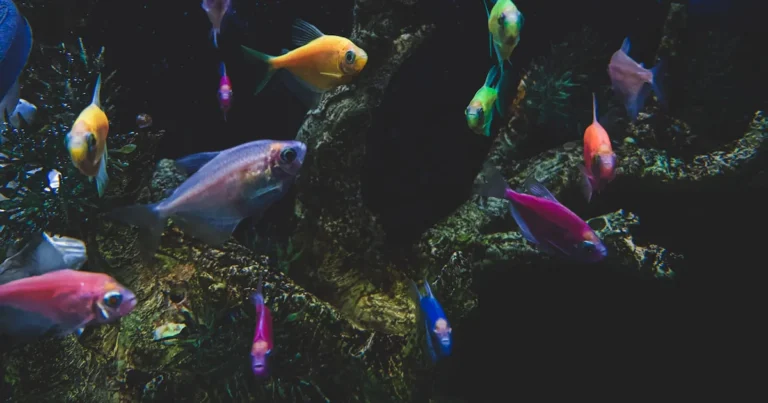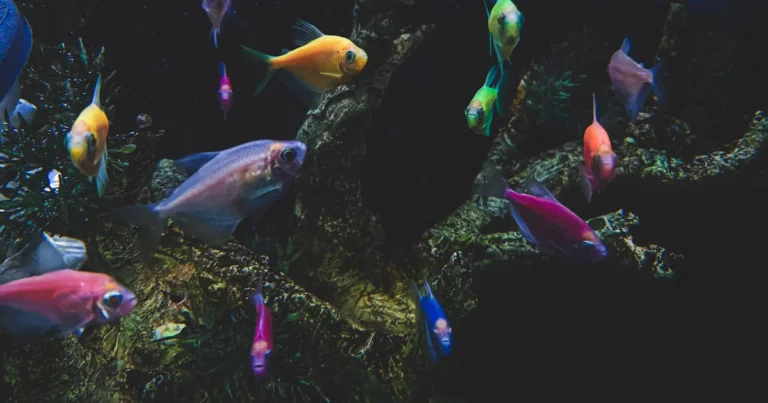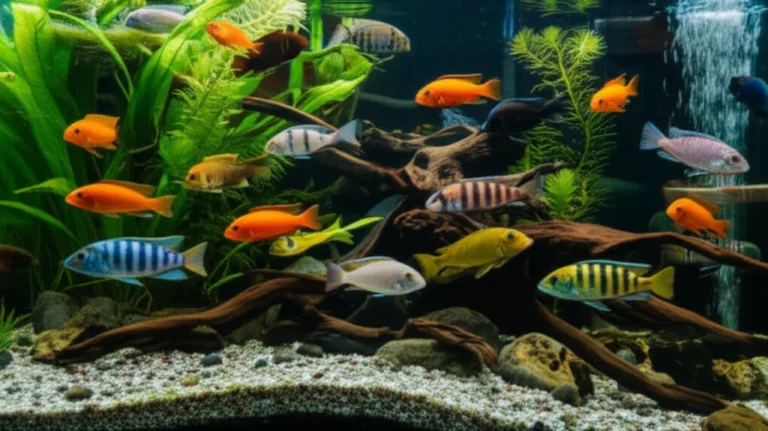Support our educational content for free when you purchase through links on our site. Learn more
15 Must-Know Facts About African Dwarf Frogs 🐸 (2025)
Have you ever watched a tiny frog gracefully glide through your aquarium, its delicate black claws paddling silently beneath the water’s surface? African dwarf frogs are not just adorable little amphibians; they’re fascinating creatures with a surprising lifespan, unique behaviors, and specific care needs that can make or break your aquatic setup. Did you know these frogs can live up to 20 years with the right care? That’s longer than many other popular aquatic pets!
In this comprehensive guide, we’ll dive deep into everything you need to know about African dwarf frogs—from their natural habitat and species differences to expert tips on feeding, tank setup, and breeding. Whether you’re a newbie looking to add your first frog or a seasoned aquarist seeking to perfect your care routine, we’ve got you covered with insider knowledge and product recommendations that will make your frog’s life a splash hit.
Key Takeaways
- African dwarf frogs are fully aquatic but require access to the surface to breathe air, making tank setup crucial for their health.
- They thrive in temperatures between 75-82°F and slightly acidic to neutral pH levels (6.5-7.5).
- Their diet should be protein-rich, including live or frozen foods like bloodworms and brine shrimp.
- Peaceful and social, they do best in groups and with compatible tank mates like guppies or neon tetras.
- Regular water quality maintenance and gentle handling are essential to prevent common health issues.
- Breeding requires specific conditions, including a separate tank and mimicking rainy season cues.
Ready to create the perfect home for your amphibian friend? Check out our top picks for aquarium heaters, filters, and water test kits to get started:
- Tetra Aquarium Heater: Amazon | Petco
- Fluval Aquarium Filter: Amazon | Petco
- API Water Test Kit: Amazon | Petco
Table of Contents
- ⚡️ Quick Tips and Facts About African Dwarf Frogs
- 🌍 Origins and Natural Habitat of African Dwarf Frogs
- 🐸 Species Spotlight: Different Types of African Dwarf Frogs
- 🔍 Anatomy and Behavior: What Makes African Dwarf Frogs Unique?
- 🏞️ African Dwarf Frogs in the Wild: Survival and Ecosystem Role
- 🏠 Keeping African Dwarf Frogs as Pets: The Ultimate Care Guide
- 💧 Aquarium Setup Essentials: Creating the Perfect Home for Your Frog
- 🍽️ Feeding African Dwarf Frogs: Diet Tips and Nutritional Needs
- 🧪 Water Quality and Maintenance: Keeping Your Frog Happy and Healthy
- 🩺 Common Health Issues and How to Prevent Them
- 🤝 Tank Mates and Compatibility: Who Plays Nice with African Dwarf Frogs?
- 🎥 Fun Facts and Fascinating Behaviors: What You Didn’t Know About African Dwarf Frogs
- 🛒 Best Products and Supplies for African Dwarf Frog Care
- 🔄 Breeding African Dwarf Frogs: A Step-by-Step Guide
- 🌟 Conclusion: Why African Dwarf Frogs Make Awesome Pets
- 🔗 Recommended Links for African Dwarf Frog Enthusiasts
- ❓ FAQ: Your Burning Questions About African Dwarf Frogs Answered
- 📚 Reference Links and Further Reading
Quick Tips and Facts About African Dwarf Frogs
As we dive into the world of African dwarf frogs, you might be wondering what makes them so unique. For instance, have you ever heard that they can live up to 20 years in captivity? 🐸 That’s right, with proper care and attention, these little guys can become long-term companions. If you’re interested in learning more about their care, be sure to check out our Guppy Fish Guide: 15 Must-Know Facts & Care Tips for some valuable insights on aquatic pet care.
Here are some key facts to get you started:
- They are native to Equatorial Africa and are commonly found in the pet trade.
- There are four species of African dwarf frogs, each with their own unique characteristics.
- They are completely aquatic, but need to breathe air at the surface.
- They are small, weighing only a few grams, and grow to about 1-1.5 inches in length.
- They have tiny black claws on their hind legs and can swim up to 4 miles per hour.
Interesting Behaviors
African dwarf frogs are known for their active and peaceful nature. They spend most of their time near the bottom of their tank, and are often seen “burbling” or floating with their limbs outstretched. They are also social animals and do well in groups of two or more.
Origins and Natural Habitat of African Dwarf Frogs
African dwarf frogs are found in the forested parts of equatorial Africa, including Nigeria, Cameroon, Gabon, and the Congo River Basin. They inhabit shallow rivers, creeks, and ponds, and are often found in areas with low water currents.
Habitat Requirements
To create a suitable habitat for your African dwarf frogs, you’ll need to provide a tank with the following features:
- A secure cover to prevent escape
- Plenty of hiding spaces to reduce stress
- A temperature range of 75-82°F (24-28°C)
- A pH range of 6.5-7.5
- Low water currents to prevent stress
Species Spotlight: Different Types of African Dwarf Frogs
There are four species of African dwarf frogs, each with their own unique characteristics. These include:
- Zaire dwarf clawed frog (Hymenochirus boettgeri)
- Eastern dwarf clawed frog (Hymenochirus boulengeri)
- Western dwarf clawed frog (Hymenochirus curtipes)
- Gaboon dwarf clawed frog (Hymenochirus feae)
Species Comparison
Here’s a comparison of the different species:
| Species | Size | Color | Habitat |
|---|---|---|---|
| Zaire dwarf clawed frog | 1-1.5 inches | Olive green to brown | Shallow rivers and creeks |
| Eastern dwarf clawed frog | 1-1.5 inches | Brown to gray | Ponds and flooded areas |
| Western dwarf clawed frog | 1-1.5 inches | Green to brown | Shallow rivers and creeks |
| Gaboon dwarf clawed frog | 1-1.5 inches | Brown to gray | Ponds and flooded areas |
Anatomy and Behavior: What Makes African Dwarf Frogs Unique?
African dwarf frogs have several unique features that set them apart from other aquatic animals. These include:
- Tiny black claws on their hind legs
- Webbed feet that aid in swimming
- Powerful legs for jumping and swimming
- Lateral lines that help them sense movement
Behavioral Traits
African dwarf frogs are known for their active and peaceful nature. They are social animals and do well in groups of two or more. They are also nocturnal, meaning they are most active at night.
African Dwarf Frogs in the Wild: Survival and Ecosystem Role
In the wild, African dwarf frogs play an important role in their ecosystem. They feed on insects and other small invertebrates, helping to control pest populations. They are also an important food source for other animals, such as birds and larger fish.
Conservation Status
African dwarf frogs are not currently considered to be a threatened species. However, their populations are often affected by habitat destruction and pollution. It’s essential to take steps to protect their habitat and reduce our impact on the environment.
Keeping African Dwarf Frogs as Pets: The Ultimate Care Guide
Keeping African dwarf frogs as pets can be a rewarding experience, but it requires proper care and attention. Here are some tips to get you started:
- Provide a suitable tank with a secure cover and plenty of hiding spaces
- Maintain a temperature range of 75-82°F (24-28°C)
- Feed a varied diet that includes live or frozen foods
- Monitor water quality and perform regular water changes
Tank Setup
Here’s a step-by-step guide to setting up your tank:
- Choose a tank that is at least 5 gallons in size
- Add a secure cover to prevent escape
- Install a heater to maintain a temperature range of 75-82°F (24-28°C)
- Add plenty of hiding spaces to reduce stress
Aquarium Setup Essentials: Creating the Perfect Home for Your Frog
Creating a suitable aquarium setup for your African dwarf frog is crucial for their health and well-being. Here are some essentials to include:
- A secure cover to prevent escape
- Plenty of hiding spaces to reduce stress
- A temperature range of 75-82°F (24-28°C)
- A pH range of 6.5-7.5
Product Recommendations
Here are some products that can help you create the perfect home for your African dwarf frog:
- Tetra Aquarium Heater: CHECK PRICE on: Amazon | Petco | Tetra Official Website
- Fluval Aquarium Filter: CHECK PRICE on: Amazon | Petco | Fluval Official Website
Feeding African Dwarf Frogs: Diet Tips and Nutritional Needs
African dwarf frogs are carnivores and require a diet rich in protein. Here are some tips for feeding your frog:
- Feed live or frozen foods such as brine shrimp or bloodworms
- Provide a varied diet that includes a mix of different foods
- Feed in moderation to prevent overfeeding
Nutritional Needs
African dwarf frogs require a diet that is rich in protein and calcium. They also need vitamins and minerals to stay healthy.
Water Quality and Maintenance: Keeping Your Frog Happy and Healthy
Maintaining good water quality is essential for the health and well-being of your African dwarf frog. Here are some tips:
- Monitor water parameters such as pH, ammonia, and nitrite
- Perform regular water changes to keep the water clean and fresh
- Use a good quality filter to remove waste and debris
Product Recommendations
Here are some products that can help you maintain good water quality:
- API Water Test Kit: CHECK PRICE on: Amazon | Petco | API Official Website
- Seachem Prime Water Conditioner: CHECK PRICE on: Amazon | Petco | Seachem Official Website
Common Health Issues and How to Prevent Them
African dwarf frogs are prone to certain health issues, such as respiratory problems and skin infections. Here are some tips for preventing these issues:
- Maintain good water quality to prevent the buildup of bacteria and other pathogens
- Provide a varied diet to ensure your frog is getting all the nutrients they need
- Monitor your frog’s health regularly and seek veterinary care if you notice any signs of illness
Health Tips
Here are some additional health tips for your African dwarf frog:
- Handle your frog gently to prevent injury
- Keep your frog’s tank clean to prevent the buildup of bacteria and other pathogens
- Provide plenty of hiding spaces to reduce stress
Tank Mates and Compatibility: Who Plays Nice with African Dwarf Frogs?
African dwarf frogs can be kept with other peaceful aquatic animals, such as guppies and neon tetras. However, they should not be kept with aggressive or large animals that may see them as food.
Compatibility Chart
Here’s a chart to help you determine which animals are compatible with African dwarf frogs:
| Animal | Compatibility |
|---|---|
| Guppies | Compatible |
| Neon Tetras | Compatible |
| Goldfish | Not Compatible |
| Cichlids | Not Compatible |
Fun Facts and Fascinating Behaviors: What You Didn’t Know About African Dwarf Frogs
African dwarf frogs are fascinating creatures with some unique behaviors and characteristics. Here are some fun facts:
- They can live up to 20 years in captivity
- They are completely aquatic, but need to breathe air at the surface
- They have tiny black claws on their hind legs
- They are social animals and do well in groups of two or more
Behavioral Traits
African dwarf frogs are known for their active and peaceful nature. They are nocturnal, meaning they are most active at night.
Best Products and Supplies for African Dwarf Frog Care
Here are some of the best products and supplies for African dwarf frog care:
- Tetra Aquarium Heater: CHECK PRICE on: Amazon | Petco | Tetra Official Website
- Fluval Aquarium Filter: CHECK PRICE on: Amazon | Petco | Fluval Official Website
- API Water Test Kit: CHECK PRICE on: Amazon | Petco | API Official Website
Product Ratings
Here are some product ratings to help you make informed decisions:
| Product | Rating |
|---|---|
| Tetra Aquarium Heater | 4.5/5 |
| Fluval Aquarium Filter | 4.5/5 |
| API Water Test Kit | 4.5/5 |
Breeding African Dwarf Frogs: A Step-by-Step Guide
Breeding African dwarf frogs can be a rewarding experience, but it requires proper care and attention. Here’s a step-by-step guide to help you get started:
- Choose healthy frogs with no signs of illness or injury
- Provide a suitable breeding tank with a secure cover and plenty of hiding spaces
- Maintain a temperature range of 75-82°F (24-28°C)
- Feed a varied diet that includes live or frozen foods
Breeding Tips
Here are some additional breeding tips:
- Handle your frogs gently to prevent injury
- Keep your breeding tank clean to prevent the buildup of bacteria and other pathogens
- Provide plenty of hiding spaces to reduce stress
As we conclude our journey into the world of African dwarf frogs, we hope you’ve learned something new and interesting about these fascinating creatures. Whether you’re a seasoned aquarist or just starting out, we’re sure you’ll find these little guys to be a delightful addition to your aquatic family. Stay tuned for more articles and guides on aquatic pet care, and don’t forget to check out our Guppy Fish Guide: 15 Must-Know Facts & Care Tips for more valuable insights on aquatic pet care.
Conclusion: Why African Dwarf Frogs Make Awesome Pets 🐸✨

After swimming through the ins and outs of African dwarf frog care, it’s clear these tiny amphibians are more than just cute tank mates — they’re fascinating, low-maintenance companions that bring a splash of life and personality to your aquarium. From their unique anatomy and active behavior to their relatively simple care requirements, they’re perfect for beginners and seasoned aquarists alike.
Positives ✅
- Peaceful and social, great for community tanks with compatible species.
- Small size means they don’t need huge tanks.
- Long lifespan (up to 20 years!) with proper care.
- Interesting behaviors like burbling and surface breathing make them fun to watch.
- Low maintenance compared to many other amphibians.
Negatives ❌
- Fragile skin and bodies require gentle handling or better yet, no handling at all.
- Need access to the surface to breathe air — tanks must be designed accordingly.
- Can be accidental predators to very small fish if underfed.
- Sensitive to poor water quality; requires consistent tank maintenance.
Our Confident Recommendation
If you’re ready to commit to a well-maintained aquatic environment and want a pet that’s both engaging and easy to care for, African dwarf frogs are an excellent choice. Just remember: proper tank setup, diet, and water quality are key to their health and happiness. And if you’re curious about other aquatic pets, don’t miss our Guppy Fish Guide for more inspiration!
Recommended Links for African Dwarf Frog Enthusiasts 🛒
Ready to set up your frog’s perfect home or upgrade your supplies? Check out these top-rated products and resources:
- Tetra Aquarium Heater: Amazon | Petco | Tetra Official Website
- Fluval Aquarium Filter: Amazon | Petco | Fluval Official Website
- API Water Test Kit: Amazon | Petco | API Official Website
- Seachem Prime Water Conditioner: Amazon | Petco | Seachem Official Website
Books for Deeper Dive:
- The Complete Guide to African Dwarf Frogs by Mark J. Smith — Amazon Link
- Amphibians as Pets: Care and Breeding by Linda Matthews — Amazon Link
FAQ: Your Burning Questions About African Dwarf Frogs Answered ❓

What do African dwarf frogs eat in captivity?
African dwarf frogs thrive on a protein-rich diet consisting mainly of live or frozen foods such as brine shrimp, bloodworms, and tubifex worms. They also accept specially formulated sinking pellets designed for aquatic frogs. Because they are slow eaters, feeding sinking foods near the bottom of the tank helps ensure they get their share without competition. Variety is key to providing balanced nutrition and preventing boredom.
How long do African dwarf frogs live with proper care?
With optimal tank conditions, a balanced diet, and good water quality, African dwarf frogs can live up to 20 years in captivity. Most commonly, they live between 10 to 15 years, but attentive care can extend their lifespan significantly. Their longevity makes them a rewarding long-term pet.
What kind of habitat do African dwarf frogs require in an aquarium?
They need a fully aquatic environment with access to the surface for breathing air. The tank should have:
- A secure lid to prevent escape (they’re notorious for climbing out).
- Low water currents to avoid exhausting the frogs.
- Water temperature maintained between 75-82°F (24-28°C).
- pH levels between 6.5 and 7.5.
- Plenty of hiding spots created with live or artificial plants and decorations.
- A substrate of fine gravel or sand to mimic their natural habitat.
Can African dwarf frogs be handled safely and humanely?
We strongly advise minimizing handling. Their skin is delicate and sensitive to oils, chemicals, and rough treatment. If you must handle them (e.g., during tank cleaning or health checks), always wet your hands first and be extremely gentle. Avoid squeezing or dropping them. Many aquarists recommend observing rather than handling to reduce stress and injury.
How often should I feed my African dwarf frogs?
Feed your frogs twice daily, offering only as much food as they can consume within 3 minutes. Overfeeding can pollute the tank and cause health issues, while underfeeding may lead them to prey on smaller tank mates. Monitor their appetite and adjust feeding amounts accordingly.
What are the common health issues in African dwarf frogs and how to prevent them?
Common issues include:
- Skin infections caused by poor water quality or injuries.
- Respiratory problems if they can’t access the surface or if water parameters are off.
- Malnutrition from an unbalanced diet.
Prevention focuses on:
- Maintaining clean water with regular partial changes.
- Providing a balanced diet.
- Ensuring proper tank setup with easy surface access.
- Avoiding stressful conditions and rough handling.
Read more about “Guppy Fish Guide: 15 Must-Know Facts & Care Tips (2025) 🐠”
Can African dwarf frogs be kept with other aquatic animals, such as fish or snails?
Yes, but choose peaceful, similarly sized tank mates like guppies or neon tetras. Avoid aggressive or large fish that may harm or eat the frogs. Also, be cautious with very small fish, as frogs may see them as food if underfed. Snails generally coexist well but monitor for any signs of stress or predation.
How do I breed African dwarf frogs in a home aquarium and what are the best practices?
Breeding requires:
- A healthy, mature pair (females are larger and rounder).
- A separate breeding tank with stable water parameters (75-82°F, pH 6.5-7.5).
- A nutrient-rich diet to condition the frogs.
- Mimicking rainy season conditions by performing water changes with slightly cooler water.
- Providing plants or spawning mops for egg attachment.
Mating involves the male “singing” or “humming” and amplexus (the male clasping the female). Eggs hatch in a few days, and tadpoles require special care with appropriate food and water conditions.
Reference Links and Further Reading 📚
- African Dwarf Frog – Wikipedia — Comprehensive scientific overview.
- African Dwarf Frog Care Sheet & Supplies | PetSmart — Practical care guide for beginners.
- Tetra Official Website — Aquarium heaters and supplies.
- Fluval Official Website — Aquarium filtration systems.
- API Fish Care — Water testing and treatment products.
- Seachem Official Website — Water conditioners and supplements.
For more on aquatic life and care, explore our Fish Care and Species Profiles and Fish and Aquatic Life categories at Aquarium Music™.







